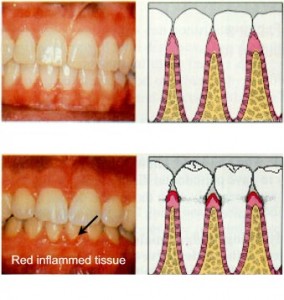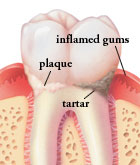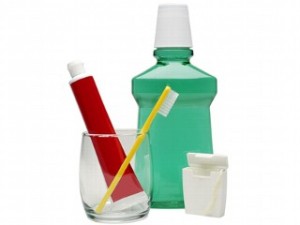A major cause of tooth loss in adults is periodontal disease. The term gum disease or periodontal disease includes both gingivitis and periodontitis, and it affects the periodontium which consists of the tissue that surrounds and supports the teeth. However with early detection and treatment of the disease, it is now possible for most people to keep their teeth for a lifetime.
What is gingivitis?
Gingivitis is the term used for the inflammation of gum tissues. It is perhaps the most common human disease, and is among the easiest to treat and control. In gingivitis, the gum margins show signs of inflammation without gum recession or bone loss. Gingivitis is directly related to the presence of bacterial plaque on the tooth surface, and the amount of time that the plaque is allowed to remain undisturbed
Chronic gingivitis is, with few exceptions, the beginning stage to the development of chronic periodontitis, but clinically, the line between chronic gingivitis and the onset of periodontitis cannot be clearly drawn. Nevertheless, one important difference is that chronic gingivitis can generally be cured by plaque control. On the other hand, the effects of chronic periodontitis that include loss of bone and tooth support are largely irreversible.
Types of gingivitis
There are several types of gingivitis and according to that of the International Workshop for a Classification of Periodontal Diseases and Conditions 1999, gingivitis can be classified into:
1.      associated with dental plaque only (for example chronic gingivitis)
2.      modified by systemic factors (for example pregnancy gingivitis and trench mouth)
3.      modified by medication (for example drug-induced gingivitis)
4.      modified by malnutrition (for example scurvy)
Gingivitis causes
Gingivitis mostly begins as an inflammation caused by an accumulation of bacterial plaque adhering to teeth, to tartar (calculus) and to fixed and removable fillings or prostheses. Dental plaque contains pathogenic (disease-causing) microorganisms that inflame the gum tissues, and are mostly retained in the mouth due to:
- Poor toothbrushing technique
- Irregular shape and placing of the teeth, providing stagnation areas
- Fillings or appliances that cause stagnation areas
Gingivitis can also be caused by systemic factors which include:
- Pregnancy
- Down’s syndrome
- Poorly-controlled diabetes mellitus
How to recognize gingivitis symptoms
Chronic gingivitis can be seen in most of the population and it is characterized by:
- tender, swollen, or red gums
- bleeding gums while brushing or flossing
- bad breath in some cases
Is gingivitis curable?
With good oral hygiene practices, a plaque-induced gingivitis of bacterial origin can be cured with gum tissues returning to normal but on the other hand, it is usually not possible for the affected tissues to return to normal in periodontitis. Therefore it is important to recognize the early signs and symptoms of gingivitis and/or periodontitis and begin immediate treatment to arrest and control the progression of the disease.
How to treat gingivitis
Gingivitis of plaque origin is a preventable and curable periodontal disease. The treatment of gingivitis can generally be divided into three phases:
1. The initial phase whereby the aim is to control or eliminate gingivitis and arrest any further progression of periodontal disease. Removal of plaque and any other factors that contribute to gingivitis is done by maintaining good oral hygiene. This effort can be done by proper toothbrushing that do no harm to the tooth or gums. Brushing alone is unlikely to clean the small spaces between the teeth therefore use of floss and interdental brushes can help enhance the cleaning of the mouth. Mouthwashes like over-the-counter products with essential oils, such as Listerine, or dentist prescribed chlorhexidine mouthrinses may help in keeping our mouths clean but it is important to remember that effective plaque removal is done by mechanical cleaning and not only by the use of mouthwashes themselves.
2. The corrective phase aims to restore function to the tissues and correcting any faulty fillings or appliances that retain plaque. Professional tooth cleaning or scaling can remove stubborn tartar or plaque in hard to reach places in the mouth.
3. The maintenance phase aims to keep our mouth in healthy condition after any correction is done by practising good oral hygiene instructions and having frequent visits to the dentist.
How to prevent gingivitis
Early detection and treatment of gingivitis can help prevent the disease progression to periodontitis. Therefore it is best to:
- Practice good oral hygiene with proper tooth brushing techniques and the usage of floss and mouthwash
- Make regular appointments with your dentist to ensure your mouth stays in a healthy condition by having professional cleaning of the teeth every 6 months or as recommended by your dentist
- Maintain good general health by having proper nutrition and exercise
- Stop smoking



Pingback: Which is the Best Mouthwash for Gingivitis? | Intelligent Dental
Pingback: Changes in Your Mouth During Pregnancy | Intelligent Dental
Pingback: How to make a Herbal Gargle to Cure Gingivitis | Intelligent Dental
Pingback: How to Use Tea Tree Oil for Dental Health | Intelligent Dental
Pingback: The Best Home Remedy for Toothache Pain | Intelligent Dental
Pingback: How to minimize side effects of using Peridex (Chlorhexidine Gluconate) | Intelligent Dental